'Around each bend, another adventure awaits': Bright colors of wildlife adorn journey in the Pantanal
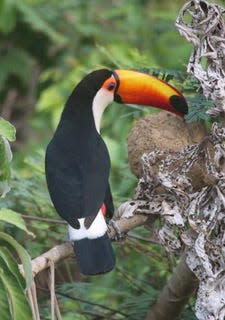
Helen Blazis of Grafton recently returned from leading a safari to the Pantanal of Brazil. Her safari included photographers from Worcester County, and the group wanted to bring home stories of experiencing such a wildlife adventure. Helen is the wife of Mark Blazis, who wrote the Outdoors column for the Telegram & Gazette until his death in 2021.
At 5:30 a.m., the sun was barely rising, and already the sky had a pinkish glow. Before I even arrived at the riverbank, I saw a green ibis probing the earth with its decurved bill. Initially, he appeared a dull brown, but as he walked into the sunlight, his neck sparkled an iridescent green. The Chaco chacalaca was easily heard before it was seen, as it bellowed out its early morning chorus. Not shy with humans, this pheasant-sized bird was frequently observed just outside our cabana.
With a blast of bright yellow-orange, a Toco toucan flew over my head. Its prominent and colorful bill contrasted with its black plumage, with a white rump and bib. Its bill was fully half the length of the bird. As the largest flying toucan, it can live up to 20 years. Like most beautiful birds, the Toco toucan possesses a disappointing “croak” of a song.
More: Birds, beasts of Brazil's Pantanal exude beauty to behold
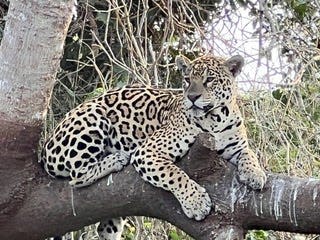
After a delicious breakfast, we boarded our boat and headed down the Cuiabá River. We wanted to see jaguar one more time. Scanning the banks, we spotted a jag on a branch over the river. Fully awake, she was ready to make her plans for the day.
We watched and photographed as she silently slipped down the tree and stealthily crept into the tall grasses. Twice as large as the jaguars in Central America, the Pantanal jaguars fear no natural predator. With an incredible bite of 2000 psi, the jaguar makes an easy kill of any caiman or capybara.
As do lions and cheetah, male jaguars have been known to form coalitions, sometimes with a brother, and sometimes with an unrelated male. This occurs as long as there are plenty of female jaguars around, as one finds in the Pantanal.
Mating takes place during the female’s 1-2 week fertile period, and copulation will occur 100 times each day. This repetition is necessary because the female jaguar will only release her egg into the fallopian tubes after she has mated several times. The barbs at the end of the male’s penis will prick the female, causing her to growl at him, followed by the release of her eggs for fertilization.
More: 'Giant River Otter!': So many more sights to see on safari to the Pantanal in Brazil
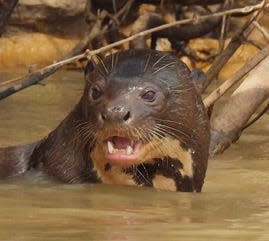
By now the sun was high, and we experienced the relentless heat of the Pantanal. Then we spotted a family of giant river otters: mother, father and sub-adult, swimming down river. Arriving at their den, the mother scampered up the clay embankment, entered the den, and emerged with a tiny, one-month-old pup, whom she bit by the scruff of the neck. She carried the pup down into the river, to let it cool off. This bothered the male who swam to the pup, grabbed it with his mouth, and returned it to the den. Up into the den went the mother to retrieve the pup.
When she returned it to the cool water, the male looked menacing as he bared his powerful canines. His concern may have been the fear that a caiman might eat his offspring. The male again bit the pup by the neck. The mother wouldn’t let go of her baby. I thought the pup would be torn in half. Finally, the mother released her grip, and the father and the pup returned to the den. Mother followed.

The sub-adult had difficulty climbing up the slippery embankment. It was then we noticed his broken left leg, perhaps the result of a predator attack. Father otter had a right to be cautious with his newborn.
Driving along the Transpantaneira dirt road, which bisects the Pantanal, we crossed 100 rickety, old bridges over the flooded sections of the Pantanal. A huge infrastructure change was on the way. Each wooden bridge was being replaced by concrete and steel. Once the project is completed, will the road be paved? Will the speed limit and amount of trucks and cars increase? Will more animals like the crab-eating fox be run over? Is that the price of progress?
More: 'Had proven the most elusive': Catching the jaguar's hunting prowess on safari in Brazil
As we drove at a slow pace, we were able to spot additional, incredible creatures like giant anteater, marsh deer, red brocket deer, brown brocket deer, Azara’s agouti, crab-eating raccoon, So. American coati, Brazilian cavy, mother and kit crab-eating foxes, black-striped tufted capuchin monkey, the southern tamandua (an arboreal anteater) and hundreds of capybara.
We encountered the near-threatened black howler monkey, which is sometimes referred to as the black-and-gold howler, as the female is blondish-gold while the male is jet black. Their booming howls could be heard for three miles! The nocturnal greater fishing bat was an occasional visitor.
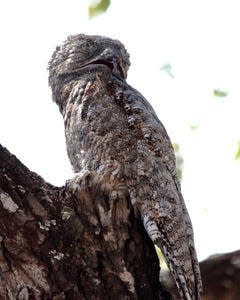
In addition to the hundreds of Yacaré caiman, other reptiles and amphibians included common tegu lizard, caiman lizard, common iguana and tree frog.
Perched high in an old tree, a cryptically plumed great potoo mimicked a tree branch. A bird of the night, he appeared asleep, though he could still see us through incisions in his upper eyelids.
Looking across a field, we spotted what looked like an ostrich. With long legs and a long neck, the flightless greater rhea is distantly related to the African ostrich and to the Australian emu. Rheas are polygamous, and it works for them.
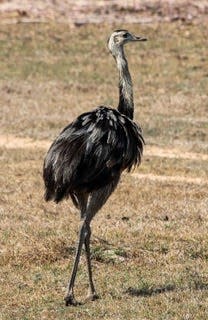
A male will mate with 2-12 females. All the females will lay their eggs in his nest. Then they leave to mate with other males. The male will incubate as many as 60 eggs. The male also will care for the young for the next six months, teaching them to feed on grasses and insects.
Our dedicated team of naturalists and photographers included Donna and Larry Reich, Ellie and Paul Horwitz, Lisa and John Rawinski and Stephanie Donaldson. With sharp eyes and good ears, we were able to identify over 150 species of birds. The Pantanal offers up its special treasures easily. Around each bend of the river, another adventure awaits.
—Contact Helen Blazis at MarkBlazisSafaris@gmail.com.
This article originally appeared on Telegram & Gazette: From sunrise, bright colors of wildlife adorn journey in the Pantanal
